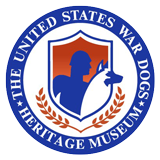Their training is intense; their working conditions are deplorable; their lives are always on the line; and in at least one case, namely Vietnam, their rewards were non-existent. This profile describes the most innocent and vulnerable of combat veterans-our Nation’s War Dogs.
Listen to: Rest of the Story, By: Paul Harvey.
NEMO’S STORY
A Brief History: Vietnam.
Military Working Dogs have been used by the U.S. Military since WW I.
The dogs were originally enlisted by the Quartermaster Corps, and a
diversity of breeds where accepted
Once knowledge and experience was gained the dogs of choice became the German Shepherd Dog and the Doberman. Due to the nature of work to be accomplished the Labrador eventually replaced the Doberman.
The German Shepherd remained the most frequently used dog. These dogs are
commonly referred to as War Dogs; however, the correct term is Military
Working Dogs. They have saved countless lives and casualties since the
beginning of their Military Service and they continue to do so today.
Dogs of Vietnam/Brief History:
There is a confirmed list of 3,747 dogs that were used in Vietnam
identified by Dr. Howard Hayes, Veterinarian (RET) of the National
Institute of Health as of March 1994, by “brand number” (a tattoo usually placed
in the left ear of the dog). However, it is estimated that approximately
4,900 dogs where used during the course of the war between 1964 and 1975.
Records of the dogs in Vietnam where not maintained by the military prior to
1968, thus the discrepancy.
How Many Dogs Returned Home?
Only 204 dogs exited Vietnam during the 10-year period. Some
remained in the Pacific, and some returned to the United States. None returned to
civilian life. So what happened to the dogs that remained? Most where
euthanized and the others where turned over to the ARVN (South Vietnamese
Army).
How Many Handlers Served in Vietnam and what Branch of Service?
All four branches of the military used dogs in Vietnam.
Approximately 10,000 handlers served. Vietnam was the largest concentrated effort of
the use of dogs and handlers in any Combat Era the United States has ever
undertaken. It is estimated that the dogs and handlers saved over 10,000 lives.
The following is a breakdown of handlers by Military Branch that
served in Vietnam. 65%Army 26%Air Force 7%Marine 2%Navy.
What Mission (duties) did the Dogs and Handlers Have in Vietnam?
Scout Dogs
A Scout Dog Team consisted of one German Shepherd and the handler.
Whenrequested the Scout Dog Team joined an infantry unit and served as
their”eyes and ears”. The Scout Dog Team walked “point” (out front) for the
unit, looking for booby trap trip wires, ambushes, hidden caches of food or
weapons, snipers etc. When the dog alerted, the handler passed the
information to the patrol leader who then moved his troops forward.
Scout dogs and handlers where trained at Ft. Benning, Ga. Some Scout Dog
handlers were trained “In-Country” (OJT) or were originally trained as Tracker
handlers.)
Combat Tracker Teams (CTT:
The Tracker Team consisted of a Labrador Retriever (Sometimes
Shepherds) and handler, a cover man, a Visual Tracker and a Team Leader. Trackers
were called to duty when the unit wished to re-establish contact with the
enemy.
Tracker teams acted much like the old Indian Scouts (except for the
use of the dogs). They were called upon to “track” either visually or by
using a Labrador Retriever to follow ground (blood trails, body odor etc.) or
airborne scent in order to locate missing personnel, i.e., downed pilots,
wounded GI’s, or the enemy. The Majority of Combat Trackers and
Tracker Dogs were trained in Malaysia at the British Jungle Warfare School (JWS) or
at Ft. Gordon, Ga. in the U.S.
Sentry Dog Teams:
Sentry Dog Teams were universal within every branch of the U.S.
Armed Forces in Vietnam to include the Air Force in Thailand; and were
normally an arm of Military Police Units (All Branches had police units-they just lcal
them different names). Sentry Dog Teams, “walked the wire” on the outskirts
of a location and their primary form of communication was via radio
after the dog alerted. Back up to the team was a tower or bunker guard, a
quick response team, or getting illumination (flares). Sentry Dog Teams (K9]
were comprised of one German Shepherd and one handler and generally worked at
night (about 99%). Their mission was to “Detect, Detain, and Destroy.
Sentry Dog Teams were the first line of defense on the perimeter of not only Bases in Vietnam but also ammo depots, supply areas, communications areas, > naval installations, camps, flight lines, and other sensitive areas.
The majority of Sentry Dog handlers and Sentry Dogs were trained at
Lackland Air Force Base, TX.
[All branches), however, some were trained in Showa(Tachikawa), Japan, and many handlers were trained “In-Country- (OJT)
Mine/Booby/Tunnel Dog Teams:
The Team was one German Shepherd and a handler in support of infantry
and combat engineer operations (Army and Marines). The mission was to
detect mines, booby-traps, trip wires, tunnel compiles and any other casualty
producing devices. They also assisted in searching villages or suspected
areas of enemy built up supplies, weapons and ammunition.
The Vietnam Veterans Memorial Wall in Washington DC honors those who died in the Vietnam War. Their relatives and friends leave letters, poems, and photographs at the Vietnam Veterans Memorial and on this web site. We bring the Vietnam Veterans Memorial to your home to help remember the sacrifices of the fallen and their families
